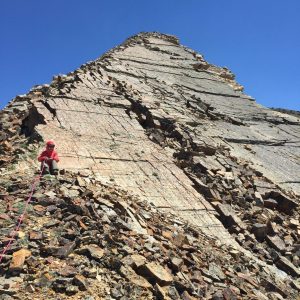Bizarre secrets of fractures in the Flathead sandstone and why they matter for geothermal everywhere
Presented by Dr. Stephen Laubach, Bureau of Economic Geology, University of Texas, Austin
March 7th (Tuesday), 6 p.m., Via Zoom (online) & Live at Teton County Library. Open to Public.
The Flathead sandstone is an iconic rock unit in the Tetons. These Middle Cambrian sandstones make up the tip of Jackson Peak, dramatic road cuts on Teton Pass, and the light colored cap rock on the summit of Mount Moran. Although notably scenic, the Flathead is a typical shallow marine deposit that is part of a thin sequence of siliciclastic strata ranging from Lower to Upper Cambrian laid down during a marine transgression over Laurentia (paleo North America). Other sandstones of this sequence include the Tapeats of the Grand Canyon, the Deadwood of southern Saskatchewan, and the Potsdam of the eastern U.S. Because across the U.S. they are typically the deepest, and therefore the hottest sedimentary rocks, these sandstones are targets for geothermal energy extraction, including commercial development in southern Saskatchewan (Deadwood) and an experimental well on the Cornell University campus in Ithaca, New York (Potsdam).
From the Rockies westward, rocks are very hot near the Earth’s surface, helping give the U.S. the world’s largest installed geothermal power generation capacity (in megawatts of electric capacity, MWe). But sedimentary basins east of the Rockies are cooler, and wells need to go to 3 to 4 km depth to find equivalent heat. Although these deeper rocks have the potential to provide heat for direct use and, in some hotter basins, even for electricity, to do so requires geology (and engineering) that allows rapid circulation of sufficient volumes of water to heat to the necessary temperatures but with flow that is not too fast and localized such that cool water breaks through.
Although the U.S. energy landscape would be transformed by this ‘geothermal everywhere’—e.g., east of the Rockies—currently, whether such systems can be made to work is unknown. Doing so requires rocks with sufficient porosity and just the right kinds of naturally occurring fractures to have large surface areas with no fast pathways. The problem is that accurately predicting fracture attributes remains one of the hardest challenges in the geosciences. Despite the fact that many outcrops, like those of the Flathead sandstone, are riddled with fractures, it is not obvious how to tell which of these fractures might exist in the deep subsurface. In the Tetons, for example, many fractures are obviously the result of loads due to steep topography or to recent fault movement. A particular problem is that many processes can create fractures that look identical. Unlike the problem Sherlock Holmes faced in ‘The Red Headed League’ with its odd but informative clues your average fracture is a crime that is too simple to figure out; there seem to be no useful hints as to where and why fractures formed.
Here we show how the seemingly simple and uninformative fractures in the Flathead, examined more closely with powerful electron microscopes, contain exceedingly strange—but highly informative—microstructures that turn out to be typical of deeply buried sandstone generally, are predictive of fracture size, abundance, and connectivity, and thus are helping us to figure out how to make geothermal everywhere work. The talk will include virtual visits to outcrops of the Flathead at Kit Lake, the Sheep Steps, Hurricane Pass, Jackson Peak, Mount Moran and elsewhere. The Flathead sandstone may well look different to you after its bizarre secrets are revealed.
Topic: Bizarre secrets of fractures in the Flathead sandstone and why they matter for geothermal everywhere
Time: Tuesday March 7th, 2023 06:00 PM Mountain Time (US and Canada)
Join Zoom Meeting
https://us02web.zoom.us/j/4555651818?pwd=U09ObDNZOEIyZmRtMEtsdUowQnJqdz09
Meeting ID: 455 565 1818
Passcode: 576063

